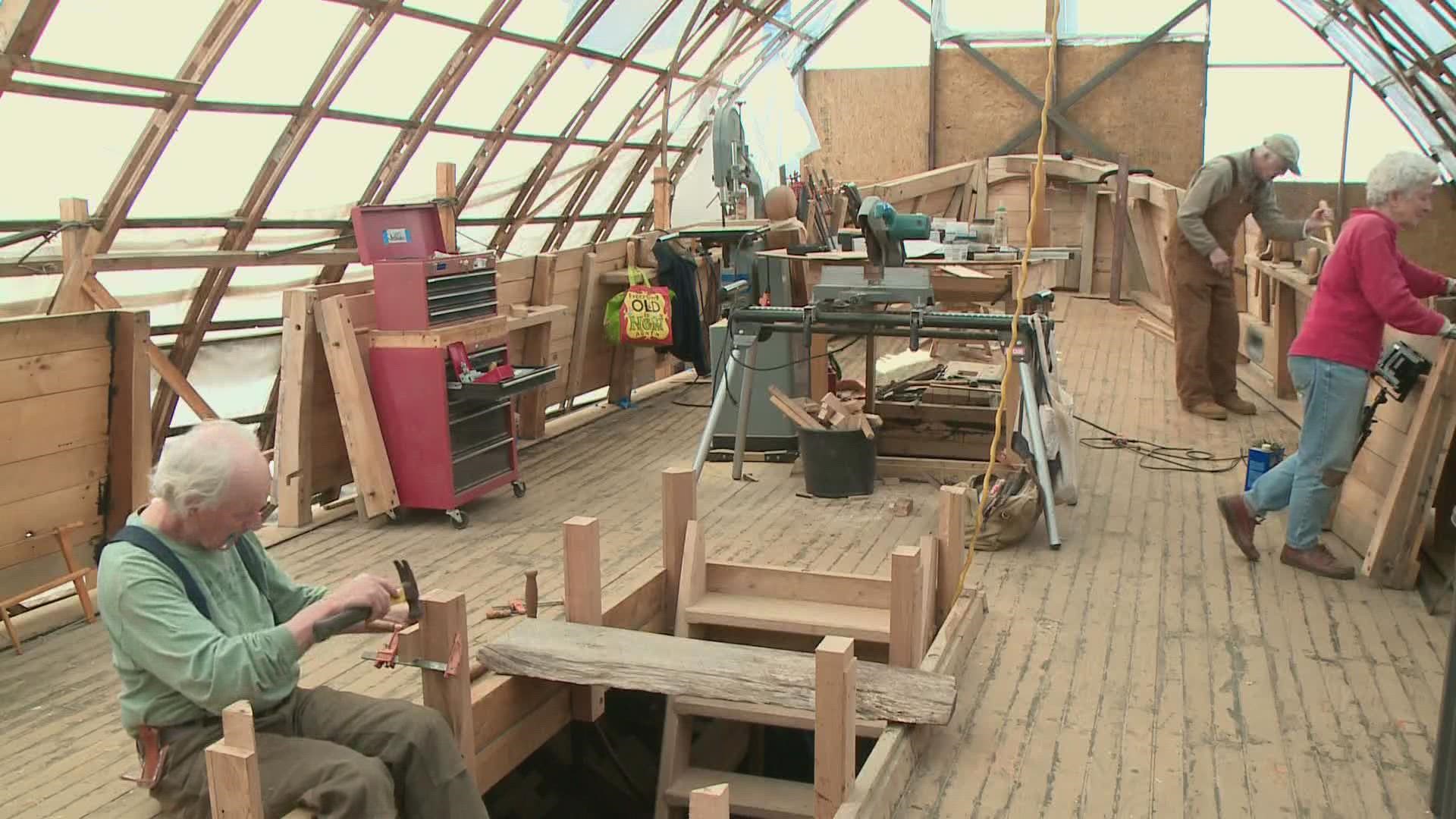BATH, Maine — The sound was apparent as visitors climbed the scaffolding, the smooth and unmistakable rhythm of a handsaw cutting wood.
That saw was in the hands of Fred Fauver, who said he'd worked with wood for years, as a job and a hobby.
"I've been making sawdust most of my life," he said.
But all those skills needed a slight adjustment when he volunteered to help build a wooden sailing ship.
"It's been new," Fauver admitted. "I usually deal with right angles and straight lines. And as you can tell, this is built with anything but right angles and straight lines."
He is helping to build — recreate, actually — a piece of Maine history.
A team of volunteers is building a replica of Virginia, the ship built by the Popham Colony at its settlement at the mouth of the Kennebec River in 1607. The Virginia is considered the first ship built by Europeans in the new world.
The project began about two decades ago as a dream, a way to celebrate the first English settlement in Maine, 13 years before the Pilgrims landed at Plymouth.
Archaeologists found traces of that short-lived settlement over the years, but there was scant information about the ship. Researchers dug into old records in London and checked in the colony at Jamestown and eventually drew a design for what the roughly 50-foot boat, called a pinnace, is believed to have looked like.
"We know the shipwright was named Digby and was from London," Jeremy Blaikloch, a board member of Maine's First Ship, the organization formed to bring the dream to life, said. "And if Digby wandered in here, he would say, 'I sort of recognize that.'"
The work is all being done by volunteers, about 160 in all, over the 13 years of the project, according to Kirstie Truluck, executive director of Maine's First Ship and the only paid staffer.
Even the shipbuilder supervising the work is a volunteer. Rob Stevens has his own boatyard, he said, but has given more than a decade of time to make sure the Virginia is properly built.
"I always say, if I build a yacht, I make one family happy. But if I do something like this, hundreds and hundreds of people will have part of this," Stevens said.
He joked about much of the work being done by people with no boatbuilding skills and about the long time it has taken to get the job done but then said Virginia is "a pretty boat."
In about a month, the world will finally get to see her.
For all the years of construction, the times of inactivity, and COVID delays, the ship has sat inside a large, white hoop house covered with plastic, almost literally in the shadow of the Bath bridge.
"I call this Bath's best-kept secret because it's been sitting under wraps for more than a decade," Truluck said.
Visitors are welcomed on Wednesdays and Saturdays, where they can view the work being done and learn more about the project and the history inside the old riverfront freight shed that is the headquarters of Maine's First Ship.
Stevens, the master boatbuilder, thinks visitors leave impressed.
"You will see people you know will never forget they had a chance to come in and see a wooden boat being built," Stevens said.
On June 4, they will get to see that boat meet the river. The plastic cover will be removed. Then large cranes will lift the Virginia from her building spot and then place her into the Kennebec River.
The volunteers say it will be a tremendous thrill to see their creation float, but the work won't be done.
The 65-foot mast, crafted from one of the famous Bowdoin pines, will be raised, and other spars will be placed. Then the hand-built rigging ropes will be installed.
"The rigging will be the main thing to do and step the masts," Elise Straus-Bowers, who has been volunteering on the project for about three years, said.
She shared some uncertainty about whether there will be more work she can do once that time comes.
"Well, he said, 'Can you climb the mast?' I said, 'If you've got a harness! I've never been in a bosun's chair, but I'm willing to do it,'" Straus-Bowers said with a laugh.
Once all the work is done, there will be time to learn how to sail the Virginia, whose 1607 alignment of masts and sails will surely look unlike anything else on the Maine coast.
The ship will be "85 to 90 percent" historically correct, Stevens said.
But she will have an engine and a propeller because, in her new life, the Virginia will be carrying school classes and other passengers and will need to guarantee they get back to the dock on schedule, regardless of winds.
The replica vessel will be a moving museum and classroom to tell the story of the river and the story of those who built her and why.
And to honor the bold settlers of the Popham Colony, who built the original Virginia more than four centuries ago on the same river.
Their settlement didn't last long, but in the years ahead others would follow with their ships. And some would stay to build Maine.

